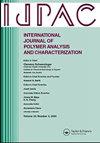Enhanced hydrophobic performance of UV-curable palm oil polyurethane by fluoroacrylate monomer
IF 1.7
4区 工程技术
Q4 POLYMER SCIENCE
International Journal of Polymer Analysis and Characterization
Pub Date : 2023-01-01
DOI:10.1080/1023666X.2023.2244823
引用次数: 0
Abstract
Driven by the versatility of crosslinked complex network formed by the reaction of double bonds during photopolymerization, ultraviolet (UV) curable palm oil polyurethane (POPU) was modified by the addition of fluoroacrylate monomer to increase its hydrophobicity properties. Fourier transform infrared spectroscopy showed a successful attachment of the fluoro group to POPU. Fluoroacrylate palm oil polyurethane (FPOPU) also showed good hydrophobic properties as FPOPU-6% has the highest contact angle which is 108.22°. In the sliding angle test, FPOPU-2% provided the highest roll-off properties with the lowest angle of incline which was 16.6°. The addition of fluoroacrylate at 6% also lowered the water absorption properties of POPU from 4.94% to 3.98%. To further investigate the cause of hydrophobicity increase, scanning electron microscopy and atomic force microscopy analysis were conducted. The morphology showed fluorine component migration increased the roughness of the coating by the coating’s hydrophobicity performance. Overall, fluoroacrylate monomer addition successfully improved the hydrophobic properties of POPU.
氟丙烯酸酯单体增强光固化棕榈油聚氨酯的疏水性
摘要利用光聚合过程中双键反应形成的交联复杂网络的通用性,通过添加氟丙烯酸酯单体对可紫外光固化的棕榈油聚氨酯(POPU)进行改性,以提高其疏水性。傅里叶变换红外光谱显示氟基团成功地附着在POPU上。氟丙烯酸酯棕榈油聚氨酯(FPOPU)也表现出良好的疏水性,FPOPU-6%的接触角最高,为108.22°。在滑角试验中,FPOPU-2%的滚转性能最高,倾斜角最低,为16.6°。6%氟丙烯酸酯的加入也使POPU的吸水率从4.94%降至3.98%。为了进一步研究疏水性增加的原因,进行了扫描电镜和原子力显微镜分析。形貌分析表明,氟组分的迁移通过涂层的疏水性提高了涂层的粗糙度。总的来说,氟丙烯酸酯单体的加入成功地改善了POPU的疏水性。
本文章由计算机程序翻译,如有差异,请以英文原文为准。
求助全文
约1分钟内获得全文
求助全文
来源期刊
CiteScore
3.50
自引率
5.30%
发文量
37
审稿时长
1.6 months
期刊介绍:
The scope of the journal is to publish original contributions and reviews on studies, methodologies, instrumentation, and applications involving the analysis and characterization of polymers and polymeric-based materials, including synthetic polymers, blends, composites, fibers, coatings, supramolecular structures, polysaccharides, and biopolymers. The Journal will accept papers and review articles on the following topics and research areas involving fundamental and applied studies of polymer analysis and characterization:
Characterization and analysis of new and existing polymers and polymeric-based materials.
Design and evaluation of analytical instrumentation and physical testing equipment.
Determination of molecular weight, size, conformation, branching, cross-linking, chemical structure, and sequence distribution.
Using separation, spectroscopic, and scattering techniques.
Surface characterization of polymeric materials.
Measurement of solution and bulk properties and behavior of polymers.
Studies involving structure-property-processing relationships, and polymer aging.
Analysis of oligomeric materials.
Analysis of polymer additives and decomposition products.

 求助内容:
求助内容: 应助结果提醒方式:
应助结果提醒方式:


